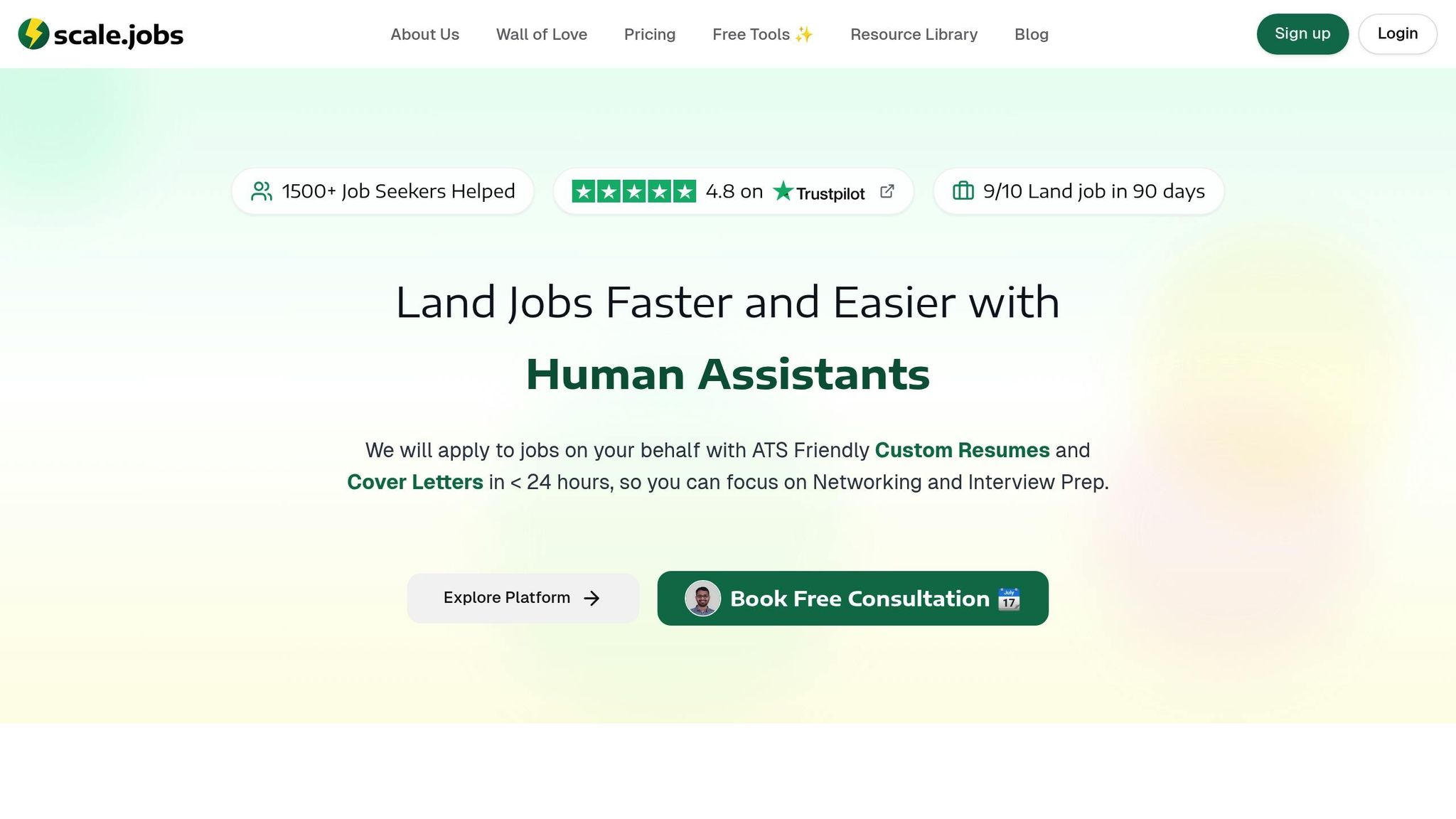How to Write a Photographer Cover Letter
Learn how to craft a compelling photographer cover letter that showcases your skills, results, and personality to stand out to employers.

Want to land your next photography gig? Start with a strong cover letter. While your portfolio shows your skills, a well-written cover letter sets you apart. It explains why you're the right fit, shares your story, and highlights what your portfolio can't - like your problem-solving approach and communication skills. Here's how to write one that stands out:
- Personalize It: Address the hiring manager by name and tailor your letter to the job.
- Showcase Results: Use metrics to highlight your impact - like increasing client satisfaction or speeding up delivery times.
- Highlight Skills: Mention tools like Lightroom, Photoshop, and drone photography expertise.
- Link Your Portfolio: Include a portfolio URL that's easy to access and relevant to the role.
- Keep It Professional: Proofread, use a clear format, and avoid generic statements.
A great cover letter doesn't just get you noticed - it proves you can communicate effectively, a skill every photographer needs. Now, let’s dive into the details.
How To Write Photographer Job Application Letter with Sample and Explanation | Writing Tutorials
Basic Structure of a Photographer Cover Letter
A well-crafted cover letter is your chance to complement your portfolio and resume by presenting a concise, engaging narrative of your skills and experience. It follows a standard business format that aligns with what U.S. employers typically expect. Think of it as your professional introduction, with each section playing a key role in showcasing why you’re the ideal photographer for the job.
Header and Contact Information
Start with your full name in a larger font, followed by your phone number (e.g., (555) 123-4567), professional email address, city and state, LinkedIn profile, and - most importantly - a portfolio URL. This could link to platforms like Adobe Portfolio or your personal website.
Make sure your email address is professional (no quirky usernames or outdated providers). Since U.S. employers often prioritize easy access to your visual work, your portfolio link is a critical element. If you’re applying from outside the U.S., it’s a good idea to mention your work authorization status early on to address any potential questions.
Once your contact details are in place, move on to a personalized greeting that sets the tone for your application.
Greeting and Opening Paragraph
Whenever possible, address the hiring manager by name. If you can’t find it in the job posting, on the company’s website, or via LinkedIn, use a general greeting like "Dear Hiring Manager" or "Dear Photography Team."
In your opening paragraph, clearly state the position you’re applying for, where you found the job listing, and what makes your photography skills stand out.
"As a passionate photographer with over a decade of experience capturing life’s most compelling moments, I was excited to see your job posting for a professional photographer at XYZ Studio. My unique combination of technical expertise, creative vision, and a deep passion for storytelling has allowed me to produce high-quality, impactful images for a diverse range of clients. My work has been featured in publications like National Geographic and Time Magazine, showcasing my ability to adapt to various styles and themes. I’m confident my skills and experience can bring a fresh perspective to your team." (Source: tealhq.com, 2025)
This kind of opening grabs attention by establishing credibility and showing genuine enthusiasm for the role.
Body Paragraphs: Highlighting Skills and Results
The body of your cover letter should focus on measurable accomplishments and technical skills that align with the job description. Instead of simply listing the equipment you use, describe how your expertise has delivered tangible results.
For example, highlight your proficiency with tools like Adobe Lightroom, Photoshop, and Capture One, and link these skills to real-world outcomes. You might explain how your editing workflow reduced client delivery times or how your lighting techniques enhanced client satisfaction. Whenever possible, include specific numbers - such as the number of events you’ve covered or increases in client retention - to demonstrate your impact.
If the role emphasizes a specific photography niche, such as product photography, tailor your examples accordingly. Discuss your experience with various lighting setups, your ability to follow brand guidelines, and how your images have supported marketing campaigns effectively.
Wrap up the body by summarizing your qualifications and reinforcing your enthusiasm for the role.
Closing and Signature
In your closing paragraph, reaffirm your interest in the position and express excitement about the opportunity to contribute to the team. Mention that you’ve attached your resume and invite the employer to review your portfolio for additional context.
End with a professional closing, such as "Sincerely" or "Best regards", followed by your full name. If submitting a hard copy, leave space for a handwritten signature above your typed name. Be sure to include your availability for an interview, as photography roles often involve detailed discussions about your visual work.
What to Include in a Photographer Cover Letter
Crafting a standout photographer cover letter means going beyond the basics. Use this opportunity to highlight your technical skills, creative achievements, and the measurable impact of your work. Tailor each section to reflect your expertise and align with the job's requirements.
Technical Skills to Highlight
Showcase your expertise with industry-standard tools and equipment to emphasize your technical proficiency:
- Editing Software: Proficiency in Adobe Creative Suite, including Lightroom for RAW processing, Photoshop for advanced retouching, and Bridge for workflow management.
- Additional Tools: Experience with Capture One Pro, Final Cut Pro, and DaVinci Resolve for added versatility.
- Camera Systems: Familiarity with systems like the Canon EOS R5, Nikon Z9, or Sony α7R V, along with expertise in lenses suited for various scenarios.
- Lighting Equipment: Knowledge of studio strobes, LED panels, and portable flashes to ensure professional-grade lighting setups.
- Workflow Management: Experience with cloud storage platforms like Dropbox Business, file organization, and efficient delivery processes.
If you have skills with emerging technologies, such as drone photography (e.g., holding a Part 107 license) or creating virtual reality content, be sure to mention them. These can set you apart in industries like real estate, tourism, and commercial photography.
Once you’ve outlined your technical abilities, back them up with real-world examples of how you’ve applied these skills in your work.
Showcasing Your Best Work
Concrete examples of your achievements help your cover letter stand out. Instead of vague statements like being "passionate about wedding photography", focus on measurable outcomes. For instance, describe how your wedding photography improved client satisfaction or how your images helped an event venue attract more bookings.
For commercial photographers, detail the tangible results of your work. Did your product photography increase an e-commerce store's conversion rates? Did your corporate headshots contribute to a successful rebranding campaign? If you’ve worked with well-known brands, mentioning these collaborations can add credibility.
Don’t forget publication credits or awards. If your work has been featured in major outlets like Condé Nast Traveler or if you’ve received recognition in professional photography contests, include these as third-party endorsements of your talent.
Event photographers should highlight their ability to handle high-pressure situations. Mention the scale and variety of events you’ve covered, emphasizing your reliability and adaptability during demanding assignments.
Including a Link to Your Portfolio
Your portfolio is your calling card, so include a link in both the header and closing of your cover letter. Tailor your portfolio to showcase work that aligns with the job's focus. Make sure it’s mobile-friendly and loads quickly - hiring managers often spend only a few moments reviewing it.
To stand out, consider adding behind-the-scenes content. Time-lapse videos of your studio setups, client testimonials, or before-and-after editing comparisons can give potential employers a deeper understanding of your creative process and professionalism. Including image metadata, such as camera settings or lighting setups, can further demonstrate your technical expertise.
If you’ve worked on confidential projects, mention your discretion and commitment to client privacy. This reinforces your professionalism and builds trust.
Tailoring Your Cover Letter for Different Photography Jobs
When applying for photography roles, it's crucial to adapt your cover letter to the specific niche you're targeting. A wedding photographer's strengths differ from those of a product photographer, and your application should reflect these distinctions. By understanding what each type of employer values most, you can craft a message that resonates with hiring managers.
Writing for Specific Photography Types
Event photography demands the ability to handle high-pressure situations and capture fleeting moments. Highlight your experience working in dynamic environments with unpredictable lighting and fast-paced scenarios. Mention your proficiency with quick autofocus systems and your knack for anticipating key moments before they unfold. If you've worked at prominent events or with high-profile clients, include these experiences to showcase your reliability.
This type of photography also requires strong interpersonal skills. Event photographers often coordinate with vendors, guide family members during portraits, and blend into the scene without disrupting the event. Share examples of how you've balanced creative vision with meeting the needs of multiple stakeholders.
Product photography, on the other hand, is all about precision and technical expertise. Emphasize your skills in lighting setups, color accuracy, and post-processing techniques. If you've mastered specialized approaches like focus stacking for intricate items or creating seamless white backgrounds for e-commerce, be sure to mention them. Experience with 360-degree product photography or Amazon listings is particularly valuable.
Collaboration is key in this field, so highlight your ability to work with marketing teams and follow brand guidelines. Show that you can translate a company's identity into visually compelling content while meeting commercial objectives.
Real estate photography requires a keen eye for architecture and technical skills with tools like wide-angle lenses, HDR imaging, and drone photography (especially if you're Part 107 certified). Talk about your expertise in capturing twilight shots and staging spaces to appear inviting and spacious.
Since real estate photography often involves tight deadlines, emphasize your efficiency and dependability. If your work has helped properties sell faster or earned praise from real estate agents, include these achievements to demonstrate your impact.
Portrait photography is all about connecting with people and bringing out their personality in the images. Discuss your ability to make subjects feel at ease and your experience with various lighting setups, from natural light to complex studio arrangements. If you specialize in corporate headshots, mention your understanding of professional standards and your ability to work efficiently with busy executives.
Using Numbers and Results for Impact
Once you've tailored your cover letter to a specific niche, use metrics to back up your claims. Quantifiable results help demonstrate your expertise and the value you bring.
For event photography, focus on client satisfaction and volume. For example, mention that you've photographed over 150 weddings with a 98% client satisfaction rate, generating 40+ referrals in the past two years. Highlight your ability to manage long shifts or multiple events in a single weekend.
Product photographers should showcase their impact on business outcomes. Instead of simply stating your e-commerce experience, mention that your product images "increased conversion rates by 35% for a fashion retailer" or that you've "completed 500+ product shoots for Amazon sellers with a 48-hour turnaround." If your images were featured in successful ad campaigns, include metrics like engagement or reach.
For real estate photography, use market data to demonstrate your value. You could write that properties you've photographed "sold 25% faster than the local market average" or that you've "completed over 300 property shoots, with 95% of listings receiving offers within 30 days." If you've worked with top agents or luxury properties, mention the price ranges to position yourself as a premium choice.
Portrait photographers can emphasize client loyalty and session volume. For instance, you might share that you've "maintained a 90% client return rate for annual corporate headshot updates" or "completed 200+ individual portrait sessions in 2024." If your work has been featured in publications or you've photographed notable clients, these details can add significant weight to your application.
Tools and Platforms for Cover Letter Writing
As mentioned earlier, crafting a tailored cover letter is crucial for standing out in photography job applications. While you can use basic word processors to get started, specialized tools can make the process smoother and more efficient. The right platform not only saves time but also ensures your application highlights your unique creative strengths. For photographers juggling diverse opportunities - from wedding shoots to corporate gigs - having a tool that adapts to these varying needs is a game-changer.
Let’s take a closer look at two popular platforms to see why scale.jobs emerges as a better fit for photographers.
Comparison: scale.jobs vs ResumeGenius

ResumeGenius is a widely-used platform offering generic templates with basic customization. While it’s a good starting point, it often lacks the industry-specific focus that photographers need. On the other hand, scale.jobs combines AI technology with human expertise to deliver tailored solutions for creative professionals.
| Feature | ResumeGenius | scale.jobs |
|---|---|---|
| Pricing Model | Subscription-based | Free tier with one-time campaign bundles ($199–$1,099) |
| AI Customization | Basic templates | Advanced, AI-generated cover letters tailored for creatives |
| Human Support | Email-only support | Real-time assistance via WhatsApp |
| Industry Focus | General templates | Specialized for creative industries, including portfolio integration |
| Application Management | Cover letter creation only | End-to-end application tracking and submission tools |
Unlike ResumeGenius, scale.jobs takes customization to the next level by assigning trained virtual assistants who specialize in the photography industry. These assistants don’t just help write cover letters - they research companies, tailor applications for specific niches, and even handle submissions across job portals.
Why scale.jobs Stands Out
Here’s what makes scale.jobs a better choice for photographers:
- One-Time Pricing Bundles: Forget monthly subscriptions. With scale.jobs, you can opt for one-time campaign bundles. For example, the Basic plan ($199) covers up to 250 job applications, while the Standard plan ($299) supports 500 applications. These bundles include hands-on guidance, making it a cost-effective option compared to recurring fees.
- ATS Optimization: The platform ensures your cover letters are optimized to pass Applicant Tracking Systems (ATS). By including the right keywords and formatting, scale.jobs helps your application stand out, especially when applying to larger studios or corporate clients.
- Portfolio Integration: Photography jobs heavily depend on showcasing your visual work. scale.jobs assistants can seamlessly incorporate portfolio references into your cover letters, emphasizing specific shoots, technical skills, and metrics that appeal to employers.
- Real-Time Updates: With live WhatsApp updates and screenshot confirmations, you’ll get real-time notifications about your submissions. This transparency helps you track progress and refine your approach for future applications.
For those who prefer a more hands-on approach, scale.jobs also offers free tools like an ATS resume checker, cover letter generator, application tracker, and even a portfolio website builder. Plus, if you’re navigating visa sponsorships or international job markets, their assistants are equipped to help you position yourself effectively.
Final Checklist and Best Practices
Before sending off your cover letter, take the time to thoroughly review it. A polished, error-free letter not only boosts your chances of landing an interview but also demonstrates your keen attention to detail - an essential quality for any photographer.
Proofreading for Professionalism
Mistakes in your cover letter can cost you the opportunity. In fact, Zety reports that 77% of recruiters reject cover letters with spelling or grammar errors. For photographers, where precision is key, this is especially important.
Start by using digital tools like spell-check and grammar checkers, but don't stop there. Read your letter aloud to catch awkward phrasing or overlooked errors that software might miss. Be mindful of tricky word pairs like "affect" and "effect" or "compliment" and "complement."
Formatting is equally critical. Stick to professional fonts such as Arial or Cambria, use 1-inch margins, and ensure consistent spacing between paragraphs. Double-check that your contact details match your resume and follow U.S. formatting standards.
For a fresh perspective, ask a trusted friend or colleague to review your letter. After looking at the same text repeatedly, it’s easy to miss small errors that a fresh pair of eyes will catch.
Making Each Letter Personal
According to Resume Genius, personalized cover letters are 50% more likely to lead to an interview than generic ones. This makes tailoring each application a must, even when applying to multiple photography jobs.
Address the hiring manager by name whenever possible. Instead of starting with "Dear Hiring Manager", do a bit of research. Check the company website or LinkedIn to find the name of the person reviewing applications. For example, if you're applying to a wedding photography studio, you might write "Dear Sarah Thompson" after finding the studio owner’s name on their About page.
Reference specific details from the job posting to show you’ve done your homework. If the role mentions outdoor portrait experience, highlight your work with engagement shoots in natural settings. For a corporate photography job, emphasize your skills in professional headshots and office environments.
Show how your experience aligns with the company’s style and values. For instance, if the studio specializes in candid, documentary-style wedding photography, discuss your ability to capture genuine, unposed moments. This demonstrates that you understand their brand and what they’re looking for.
A personalized letter not only makes you stand out but also sets the tone for a confident and professional submission.
Submitting with Confidence
Before hitting send, give your cover letter one last review. Ensure your portfolio link works perfectly on both desktop and mobile devices - this is crucial for photographers.
Keep your letter concise and impactful. Hiring managers typically spend less than 30 seconds skimming cover letters, so focus on 3-4 paragraphs that highlight your most relevant skills and achievements. Use quantifiable results when possible, such as “completed 150 shoots annually, increasing client engagement by 30%.”
Save your cover letter as a PDF with a clear, professional file name like "Firstname_Lastname_CoverLetter.pdf." This helps preserve formatting and makes it easy for hiring managers to find.
If you’re juggling multiple applications, tools like scale.jobs can simplify the process. Their free ATS Checker ensures your cover letter is formatted to pass applicant tracking systems, while their Cover Letter Generator helps maintain consistency across applications. For photographers applying to dozens of positions, their Human Assistant service can handle personalization and final reviews, saving you valuable time while ensuring every submission meets professional standards.
FAQs
How can I make my photographer cover letter stand out for different job applications?
To make your photographer cover letter stand out, craft it specifically for each opportunity. Address the hiring manager by name, if possible, and reference the company and the role you're applying for. Highlight your skills, experiences, and achievements that align closely with the job description - whether it's expertise in specific photography styles or noteworthy projects you've completed.
Show that you've done your homework by weaving in details about the company, like their mission or recent projects that resonate with you. Use the opening and closing paragraphs to express your excitement for the position and explain how your talents align with their needs. This personalized touch not only shows genuine interest but also boosts your chances of leaving a lasting impression.
What metrics can I include in my photographer cover letter to highlight my achievements?
When writing a cover letter to highlight your photography achievements, focus on including measurable results that showcase your impact. For instance, mention the number of clients you've worked with, successful projects you've completed, awards or recognitions you've earned, or exhibitions where your work has been featured. You can also emphasize metrics like revenue generated from your services, improvements in client satisfaction rates, or increased audience engagement driven by your photography. Concrete numbers make your contributions stand out and demonstrate your value effectively.
How can I make my photography portfolio stand out when applying for jobs?
If you want your photography portfolio to grab attention, start by showcasing only your strongest work that matches what the job or employer is looking for. Keep a consistent theme throughout to reflect your personal artistic style. Whether you choose an online gallery or a printed collection, make sure it’s presented professionally. In your cover letter, reference your portfolio and explain why it’s relevant to the role, pointing out specific strengths that set you apart. Keep it fresh by updating it regularly to show your current skills, and tweak it for each application to make a memorable impact on potential employers.




